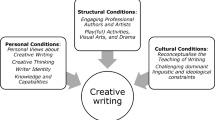Abstract
The study explores what happens to teachers practice and professional identity when they adopt a collaborative action research approach to teaching and involve external creative partners and a university mentor. The teachers aim to nurture and develop the creative potential of their learners through empowering them to make decisions for themselves about their own progress and learning directions. The teachers worked creatively and collaboratively designing creative teaching and learning methods in support of pupils with language and communication difficulties. The respondents are from an English special school, primary school and girls secondary school. A mixed methods methodology is adopted. Gains in teacher confidence and capability were identified in addition to shifts in values that impacted directly on their self-concept of what it is to be an effective teacher promoting effective learning. The development of their professional identities within a team ethos included them being able to make decisions about learning that are based on the educational potential of learners that they proved resulted in elevated standards achieved by this group of learners. They were able to justify their actions on established educational principles. Tensions however were revealed between what they perceived as their normal required professionalism imposed by external agencies and the enhanced professionalism experienced working through the project where they were able to integrate theory and practice.
Similar content being viewed by others
References
Aubusson, P., Steele, F., Dinham, S., & Brady, L. (2008). Action learning in teacher learning community formation: informative or transformative? Teacher Development, 11(2), 133–148.
Barak, M., & Doppelt, Y. (1998). Promoting creative thinking within technology education. Washington, DC: Paper Presented at the International Workshop Seminar for Scholars in Technology Education.
Beck, J. (2008). Governmental professionalism: Re-professionalising or de-professionalising teachers in England. British Journal of Educational Studies, 56(2), 119–143.
Bosher, M., & Hazlewood, P. (2008). Leading the leaders for the future. UK: Continuum.
Brighouse, T. (2008). Putting professional development centre stage. Oxford Review of Education, 34(3), 313–323.
CapeUK (2005) CARA—Building creative futures. Retrieved August 1, 2010, from CapeUK website: http://www.capeuk.org/capeuk-resources/building-creative-futures.html.
CapeUK. (2006). CARA2; the handbook. England: Arts Council.
Craft, A. (2005). Creativity in schools: Tensions and dilemmas. Abingdon, USA and Canada: Routledge.
Cresswell, J. (1998). Qualitative inquiry and research design: Choosing amongst the five traditions. California: Sage Publications.
Davies, T. (2002). Creativity: its contribution to design and technology education. Unpublished Ph. D Thesis. Reading: University of Reading.
Davies, T. (2006). Creative teaching and learning in Europe: Promoting a new paradigm. The Curriculum Journal, 17(1), 37–57.
De Bono, E. (1985). Six thinking Hats. England: Little, Brown & Company.
De Bono, E. (1992). Serious creativity. London: Harper Collins Business.
De Bono, E. (2010) The ‘six thinking hats’ for schools. Retrieved December 6, 2010, from DeBono website: http://www.edwdebono.com/shcd1.htm.
Department for Education and Employment. (1999). All our futures: Creativity culture and education. Suffolk: DFEE publications.
Ehren, M. C. M., & Visscher, A. J. (2008). The relationship between school inspections, school characteristics and school improvement. British Journal of Educational Studies, 56(2), 205–227.
Evans, L. (2008). Professionalism, professionality and the development of education professionals. British Journal of Educational Studies, 56(1), 20–38.
Feldman, D., Csikztenmihayli, M., & Gardner, H. (1995). Changing the world: A framework for the study of creativity. USA: Praeger.
Frowe, I. (2005). Professional trust. British Journal of Educational Studies, 53(1), 34–53.
Fryer, M. (1996). Creative teaching and learning. London: Paul Chapman.
Goodson, I., & Hargreaves, A. (Eds.). (1996). Teacher’s professional lives (New Prospect Series).. Abingdon: Routledge.
Handy, C. (1995). The empty raincoat. Reading: Arrow Books Ltd.
Hargreaves, A., & Shirley, D. (2009). The fourth way: The inspiring future for educational change. California: Corwin.
Hoyle, E. (1975). Professionality, professionalism and control in teaching. In V. Houghton, et al. (Eds.), Management in education: The management of organisations and individuals. London: Ward Lock Educational in association with Open University Press.
Hoyle, E. (Ed.). (1981). Managerial processes in schools. Milton Keynes: Open University Press.
Hoyle, E., & John, P. D. (1995). Professional knowledge and professional practice. London: Cassell.
Jeffrey, B., & Craft, A. (2004). Teaching creatively and teaching for creativity: Distinctions and relationship. Journal of Educational Studies, 30(1), 77–87.
LeBoeuf, M. (1994). Creative thinking. London: Judy Piatkus.
Newby, P. (2010). Research methods for education. England: Pearson.
Rogers, M., & Fasciato, M. (2005). Can creativity be assessed? Conference paper, British Educational Research Association conference September 14–17, 2005; University of Glamorgan. Retrieved October 6, 2010, from BERA website: http://www.leeds.ac.uk/educol/documents/150029.htm.
Royal Society of Arts. (2010). Opening minds. Retrieved December 6, 2010 from RSA website: http://www.thersa.org/projects/opening-minds.
Seltzer, K., & Bentley, T. (1999). The creative age: Knowledge and skills for the new economy. London: DEMOS.
Shoulksmith, G. (1970). Intelligence, creativity and cognitive style. London: Batsford.
Smyth, J. (2007) Teacher development against the policy reform grain: An argument for recapturing relationships in teaching and learning. Teacher development, 11(2), 221–236.
Torrance, E. P. (1962) Torrance tests of creative thinking. Indiana: Bensenville.
UNICEF. (2007). Report card 7, child poverty in perspective: An overview of child well-being in rich countries. Retrieved November 11, 2010, from UNICEF website: http://www.unicef-irc.org/publications/494.
Woods, P. (2002). In C. Sugrue & C. Day (Eds.), Developing teachers and teaching practice: International research perspectives. London: Routledge Falmer.
Yin, R. K. (1989). Case study research: Design and methods (revised edition). Applied Social Research Methods Series Vol. 5. CA: Sage Publications.
Acknowledgments
CapeUK who provided funding for the research and the project ‘Creativity and Action Research Awards Two’ (CARA2).
Author information
Authors and Affiliations
Corresponding author
Rights and permissions
About this article
Cite this article
Davies, T. Incorporating creativity into teachers practice and self-concept of professional identity. J Educ Change 14, 51–71 (2013). https://doi.org/10.1007/s10833-012-9192-3
Published:
Issue Date:
DOI: https://doi.org/10.1007/s10833-012-9192-3




